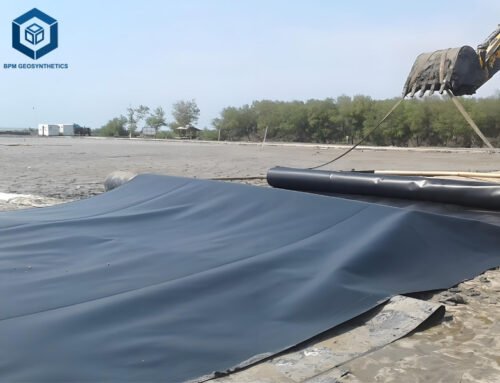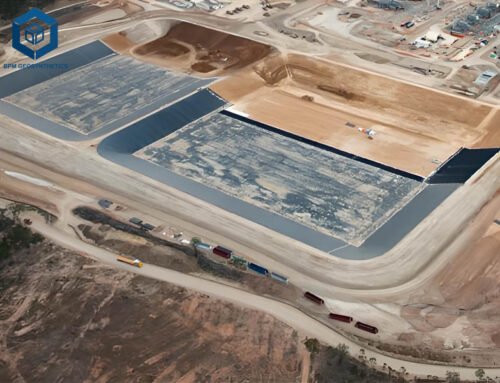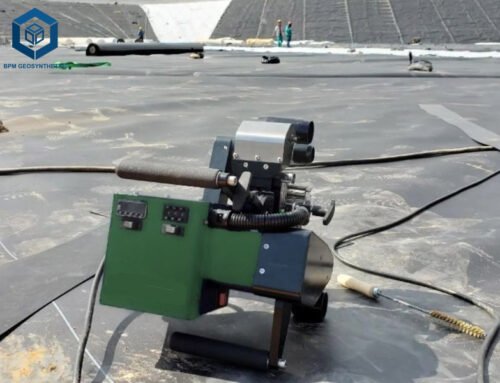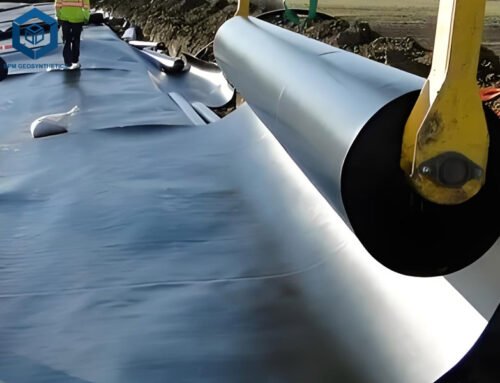In the realm of modern engineering and environmental protection, the Geomembrana liner stands as an indispensable solution to containment challenges. With applications spanning across diverse industries, from waste management to civil engineering, the Geomembrana liner plays a pivotal role in safeguarding the environment, enhancing infrastructure durability, and mitigating risks associated with fluid migration. To grasp the significance of these liners, it’s imperative to delve into their composition, properties, applications, and the meticulous processes involved in their installation and maintenance.
BPM Geomembrane is the trusted Landfill liner manufacturer and supplier, we offers a wide range of landfill liner material with custom size and thickness at best factory price.
1. What Is Geomembrana Liner?
Geomembrana liner, also known as geomembrane liner, is flexible barrier materials extensively used in geotechnical engineering for seepage control and lining applications. Comprising a plastic film as the primary impermeable layer, they are reinforced and protected by a geotextile or non-woven fabric. These impermeable membranes are employed in conjunction with rocks or earth to impede fluid migration in man-made structures.
Typically, geomembrana liners are manufactured from synthetic polymers, available in sheets ranging from 0.25 to 3.5 mm thick. Materials such as EPDM, LLDPE, HDPE, PVC, and PP are commonly utilized in the production of geomembrana liners. Their fluid-blocking capabilities make them effective in preventing the dispersion of contaminants. They can be combined with soil liners or permeable geotextiles to create composite lining systems, providing enhanced security and safeguarding against potential environmental hazards.
2. What Is The Purpose of Geomembrana Liner?
The purpose of Geomembrana liners, also known as geomembrane liners, is to provide containment, lining, and protection in various civil engineering and environmental applications. They serve critical functions in modern engineering and environmental management practices. Some of the main purposes of geomembrana liners include:
2.1 Containment:
- Geomembrana liners are designed to contain liquids, gases, or solids within a specific area. They act as barriers to prevent the migration or leakage of substances, ensuring the containment of hazardous materials, waste, or pollutants.
2.2 Seepage Control:
- These liners are used to control seepage and prevent the loss or contamination of water resources. They are applied in ponds, reservoirs, canals, and other water containment structures to minimize water loss and protect underlying soils and groundwater from contamination.
2.3 Environmental Protection:
- Geomembrana liners play a crucial role in environmental protection by preventing the migration of contaminants into the surrounding soil, groundwater, or nearby ecosystems. They are used in landfills, hazardous waste sites, and industrial facilities to minimize the impact of pollutants on the environment.
2.4 Erosion Control:
- By providing a protective barrier, geomembrana liners help prevent soil erosion caused by water flow or other external factors. They are used in erosion control applications such as slope stabilization, riverbank protection, and coastal protection.
2.5 Water Conservation:
- Geomembrana liners contribute to water conservation efforts by reducing water loss through seepage. They improve water storage efficiency in reservoirs, irrigation channels, and agricultural ponds, ensuring a more sustainable use of water resources.
2.6 Structural Stability:
- These liners enhance the stability and integrity of structures such as dams, canals, and embankments by preventing seepage-induced erosion or weakening of underlying soils. They provide additional strength and stability to the engineered structures.


3. What Is The Composition of Geomembrana Liner?
3.1 Materials used
The geomembrana liner, typically made of polyvinyl chloride (PVC), polyethylene (PE), ethylene vinyl acetate (EVA), or ethylene-based copolymer (ECB) for tunnel applications, serves as the main barrier against water seepage. These plastic materials are high-molecular-weight chemicals that offer excellent resistance to corrosion, low temperature, and deformation.
3.2 Manufacturing process
Smooth Geomembrana is manufactured by the high quality Polyethylene virgin raw material,adding carbon black,antioxidant,anti-aging and UV resistance component.BPM have the first class automatic blowing film production line and flat die production line.Textured Geomembrana is produced by the spray texture technology.It is designed with one or two side textured surface.Except for the excellent properties of smooth Geomembrana,it also has better interface friction coefficient and UV resistance.
3.3 Thickness And Durability
Engineers tailor geomembrane thickness (0.2mm–3.0mm) to project demands—landfills often require 1.0mm+ for enhanced seepage control, while chemical containment may need 1.5mm+ for corrosion resistance. Thicker liners inherently improve puncture resistance and longevity but increase material costs.
Durability depends on both design and environmental exposure:
-
Material choice: HDPE offers superior UV/chemical resistance compared to LLDPE or PVC.
-
Installation conditions: Buried liners last 15–20 years, while exposed ones degrade faster (5–7 years) under sunlight.
-
Protective measures: Geotextile underlayment and proper welding extend service life significantly.
4. What Is Geomembrana Used For?
4.1 Anti-seepage and waterproofing projects
Geomembrana is one of the main materials in anti-seepage and waterproofing projects. It can be used in various projects such as water conservancy projects, dams, reservoirs, tunnels, and basements. Its high strength, high toughness and strong impermeability can effectively prevent moisture and chemicals from penetrating into the underlying soil or groundwater, ensuring the safety and stability of the project.
4.2 Environmental protection projects
In environmental protection projects, Geomembranas are widely used in landfills, sewage treatment plants, power plant regulating pools, industrial or hospital solid waste treatment plants and other places. It can effectively prevent harmful substances from penetrating into groundwater and soil and protect the environment.
4.3 Traffic engineering
In traffic projects such as highways and railways, Geomembranas can be used for roadbed reinforcement, slope reinforcement, dam reinforcement and other projects. It can effectively enhance the strength and stability of the soil, improve the load-bearing capacity and anti-skid performance of the road surface, and ensure the safety and smoothness of traffic.
4.4 Agricultural engineering
In agricultural engineering, Geomembranas can be used in channels, reservoirs, fish ponds and other projects to improve the efficiency of water conservancy facilities and the yield of crops. In addition, Geomembranas can also be used in the drainage system of greenhouse cultivation to improve the efficiency of greenhouse cultivation.
4.5 Garden engineering
In garden engineering, Geomembrana can be used in parks, green belts, highway greening, etc. It can effectively prevent moisture and chemicals in the soil from penetrating into the underlying soil or groundwater, thereby protecting the ecological environment and improving the aesthetics of green spaces.
5. What Are Advantages Of Geomembrana Liners?
5.1 Superior Anti-Seepage Performance
HDPE geomembranes deliver exceptional impermeability, effectively isolating waste/water and preventing hazardous substance migration. Their dense molecular structure creates a near-zero permeability barrier, outperforming traditional clay or concrete liners.
5.2 Chemical & Physical Resilience
-
Resists acids, alkalis, and industrial chemicals
-
Maintains flexibility across -50°C to 80°C
-
UV-stabilized formulations combat sun degradation
5.3 Installation Advantages
-
Prefabricated panels reduce on-site welding
-
Lightweight for easier transport/handling
-
Conforms to uneven terrain with 700% elongation
5.4 Environmental & Economic Benefits
-
50+ year lifespan minimizes replacements
-
Recyclable material aligns with sustainability goals
-
Low maintenance offsets higher initial cost
5.5 Key Considerations & Solutions
Protection Measures:
-
Use geotextile underlayment against punctures
-
Select 2.0mm+ thickness for high-stress areas
-
Implement quality welding protocols for seams
Climate Adaptations:
-
Cold climates: Choose flexible LLDPE blends
-
High UV exposure: Opt for carbon-black stabilized liners
Construction Best Practices:
-
Base preparation: Remove sharp debris, grade slopes <1:3
-
Depth limitations: Combine vertical/horizontal lining systems


6. Conclusion
Geomembrana liner is an anti-seepage material widely used in civil engineering. With its excellent anti-seepage performance, chemical corrosion resistance, convenient prefabrication, strong adaptability, environmental protection and cost-effectiveness, it has become an ideal material for landfills and water conservancy projects. , environmental protection and other fields. However, as with any technology or material, Geomembranas have certain limitations and challenges. Problems such as its easy breakage, poor weather resistance, high requirements on the base surface, difficulty in construction, and possible chemical corrosion all need to be fully considered and solved in practical applications.
Nonetheless, with the continuous advancement of science and technology and the continuous accumulation of engineering practice, we believe that these problems will be gradually overcome. By improving material properties, optimizing construction processes, and improving construction quality, we can further improve the performance and reliability of Geomembranas, thereby better playing its role in civil engineering.
Geomembrana, as an important geosynthetic material, has been widely used in many fields and still has broad application prospects in the future. Let us work together to continuously promote the development and innovation of Geomembrana technology and make greater contributions to the safety, stability and sustainable development of civil engineering.
Any questions, please contact us.





